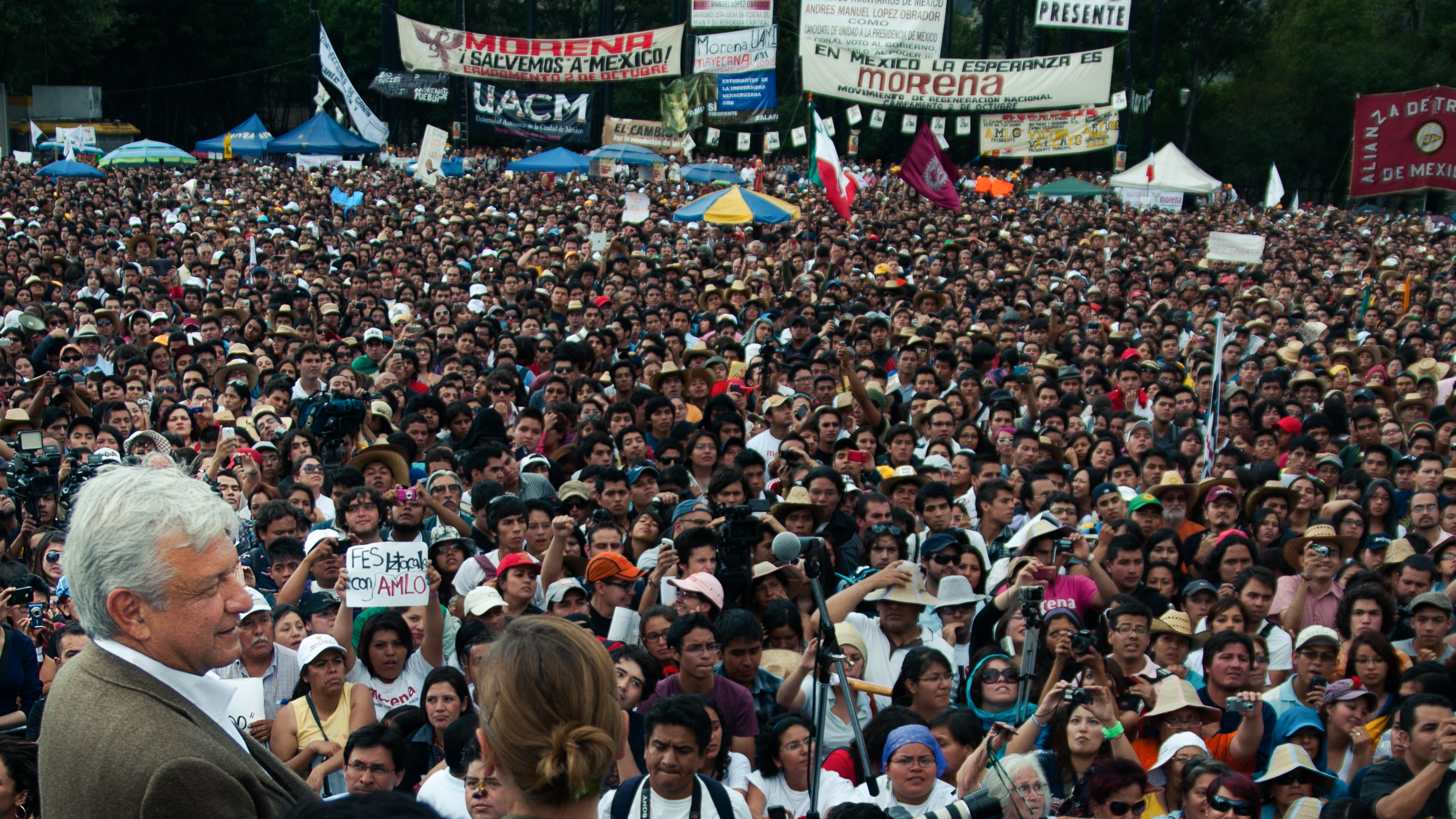Tag Archives: cannabis
Mexico’s Historic Opportunity to Get Cannabis Right
Under a Supreme Court order to legalize and regulate the drug, the country is holding a big civic discussion about exactly how best to do that.
Mexico’s Disastrous Drug War and the Plan to End It

The footage was shaky, but the screams could easily be heard. Thumping, cries for help and wails of pain left Facebook users who viewed the video baffled and unnerved. The clip was posted by Facebook user identified as Leticia, who claimed to have been placed in the care of a private addiction clinic in the Mexican city of Leon. Leticia alleged the footage was evidence her and other patients were being mistreated by their caretakers, including suffering beatings, along with both food and clothing deprivation. The footage went viral in February, but no longer appears available on social media. Speaking to a local newspaper, the manager of the clinic denied the claims, and said Leticia’s own family blocked her Facebook account “because they know it’s a lie and we don’t mistreat [patients].”
According to the manager, Leticia had spent six months in drug rehabilitation, and had made progress but became upset when her family requested she remain in the clinic’s care for an additional three months. She then convinced her fellow patients to help her stage the video in an effort to discredit the clinic. The case has not been investigated by authorities, according to newspaper El Sol de Leon.
Social media users who viewed the video were divided: was this a drug addict resorting to extreme ends to escape treatment, or a credible allegation of human rights abuses?
Part of the problem is that in Mexico, the disparate drug rehabilitation industry is increasingly being perceived as yet another source of human rights abuses linked to the country’s drug war.
Often referred to in Mexico as “anexos”, these clinics can range from professional facilities that provide comfortable care to help users with dependency and addiction problems recover, to fly-by-night operations where abuses are rife. In 2016, Vice News reporter Nathaniel Janowitz gained access to one such clinic, where he allegedly found a “room crammed with 80 addicts.”
“It’s been three months since I saw my family, since I went down the stairs,” one of the dozens of patients told Vice. “If they knew I was telling you these things, [they] would hit me.”
Prayer, Violence and Spiritual Patrols
While conditions vary from clinic to clinic, the real problem is a lack of government oversight, according to a report by the Open Society Foundations (OSF). The report indicated that Mexican authorities struggle to inspect even 10 percent of clinics, despite independent estimates that suggest over 75 percent of all private rehabilitation facilities are operating outside the law. Instead of using medically-proven addiction treatment practices, the report found many clinics rely on “chaining, public humiliation, abduction and prayer” to rehabilitate drug users.
Even the patients – or residents, as they are often called – are allegedly forced into perpetrating human rights abuses on behalf of their caretakers. “In Mexico, residents of some centers are tasked with going out to collect new recruits. These recruitment gangs are nicknamed ‘spiritual patrols’,” OSF reported.
“Roundups are often done violently and against the will of the person they are bringing in,” and can allegedly include suspected addicts being dragged from the street, hog-tied and forcibly carried to a clinic for treatment. Meanwhile, even users who desire treatment have few options available to them.
“Only three percent of the treatment centers that are currently available are run by the government, and there is a huge gap between private treatment centers for people with resources versus those who don’t, and who go to places called ‘anexos’ and which have been accused of numerous human rights violations,” said Zara Snapp, co-founder of Instituto RIA, a social justice research group based in Mexico.
Speaking to Toward Freedom, Snapp argued that Mexico needs to “expand access” to credible, professional addiction treatment for “people who use drugs who identify that they have … problematic use.” However, she pointed out there’s an even broader problem at hand: the entire debate surrounding drug policy in Mexico is mired in a false dichotomy that a drug user is “either sick or a criminal.”
This dichotomy of either incarcerating or institutionalizing users continues to underpin the government’s approach to drug policy, even under the country’s left-leaning President Andres Manuel Lopez Obrador (or AMLO for short). This is despite AMLO proposing a historic overhaul of Mexico’s drug laws, including rolling back decades of prohibition.
An End to the War on Drugs?
Mexico’s first nominally left-wing president in generations has conceded the country needs a new approach to drugs. AMLO’s landmark 2019-2024 National Development Plan stated the “’war on drugs’ has escalated the public health problem represented by … prohibited substances, and turned it into a public security crisis.”
“The only real possibility of reducing the levels of drug consumption reside in ending prohibition … and reorienting the resources currently destined to combat [drug trafficking] and apply them in massive, but personalized programs of detoxification and reintegration [of users into society].”
While treatment may be better than criminalization, drug policy expert Amaya Ordorika Imaz told Toward Freedom that treating drug use exclusively as a public health issue comes with its own set of problems.
“The national development plan is an interesting development that recognizes the failure of the entire internal security model to combat drugs … but replaces it with a medical logic for users,” she said.
“In reality … this corrective model can likewise violate human rights,” she noted, pointing to the example of the anexos and their alleged “practices of torture and mistreatment of those who enter.”
Ordorika has seen the risks posed by both the security state and pseudo-medical clinics in her work with ReverdeSer, a youth collective that advocates for policy reform and works to tackle human rights abuses linked to the drug war, such as forced disappearances. In particular, Ordorika warned that members of Mexico’s LGBTIQ community are most at risk of abuse in the private, often openly religious anexos.
However, she argued there’s a “middle point” between the two extremes of treating drugs as either a threat to national security or public health problem.
Her organization has called for a legislative framework that not only decriminalizes users, but “allows the traditional, medicinal and recreational uses of substances that are now illegal and based on a perspective of youth, gender and human rights.”
Principle not Policy?
For now, AMLO’s drug policy remains somewhat vague. While the National Development Plan conceded in principle that prohibition had failed, it didn’t set a clear road-map for exactly how the government plans to reform drug policy.
As Snapp explained, “It is important to note that the national development plan is a broad document which outlines the plans for the government but which does not specify actions.”
“We welcome the statement recognizing that prohibition is unsustainable and there needs to be a change in paradigm, but we also do not support the pathologizing of people who use drugs.”
Along with these big picture concerns, there’s also the question of details: marijuana legalization may have widespread support, but hard drugs such as heroin and methamphetamines remain difficult issues to grapple with. Demands are growing in some parts of Mexico for the legalization of poppy production, though these too have been met with concerns over how such a market could be regulated. Then there’s the broader question of supply, and whether the growing, manufacturing and distribution of narcotics could ever be not only legalized, but effectively regulated. If the Mexican government can’t provide adequate public oversight of rehabilitation clinics, how could it possibly hope to responsibly regulate meth labs?
It’s difficult questions like these that have led experts like drug market investigator Carlos Zamudio to throw up their hands in exasperation and say, “They really have no idea.”
“It seems to me that [AMLO] said this without really having much knowledge of the situation and how to regulate these things,” Zamudio recently stated.
Is Dope a Done Deal?
Zamudio concluded that despite the lofty talk of a total end to prohibition, in reality AMLO will likely settle on the decriminalization of marijuana use, and little more. Indeed, experts who spoke to Toward Freedom indicated that if nothing else, there are at least high hopes that marijuana use will become legal across Mexico under AMLO.
“We have been closely working with the Senate as they debate the bill regarding the regulation of cannabis for all uses, including adult use,” Snapp said, explaining that human rights are a priority for any legalization on the issue. “There is a hope that by implementing a law that put social justice at the center, that we can avoid some of the errors made in other jurisdictions.”
One of the central concerns is production, and ensuring an emergent legal cannabis market isn’t immediately monopolized by corporate interests. “The goal is to have many small producers, rather than have three companies that control the market,” she said.
The most prominent advocate of such a proposal is Interior Minister Olga Sanchez Cordero, who has stated that even without broader reform, legalizing marijuana would be a “major contribution to bringing peace to our beloved country.”
“She is proposing three general forms of access,” Ordorika explained.
“The first is … cultivation for personal use. The second is associations for personal cultivation – that is, where people can grow [cannabis] for personal use, but in a collective manner; and the third is commercialization [for both recreational and medicinal use].”
Like AMLO’s broader efforts at drug reform, this proposal is likewise still up in the air, with lawmakers in Mexico City reportedly using the summer congressional recess to hammer out a bill that would regulate marijuana. There’s some speculation a concrete proposal could be made public sometime in September, after the recess ends on August 31, but before a Supreme Court mandated deadline in October. Mexico’s Supreme Court has ruled on five separate occasions that banning cannabis use is unconstitutional, and demanded reform.
Along with pressure from the Supreme Court, lawmakers are also facing a surge in public support for marijuana reform. When the Secretariat of Public Security conducted an informal poll on social media asking Mexicans if they would support legalization of recreational marijuana use, 80 percent of the more than 80,000 respondents said they would approve.
“Alcohol and tobacco are much more dangerous,” one respondent tweeted to the Secretariat. “It’s urgent that [we] liberate the 60,000 Mexicans imprisoned for possession of small amounts of marijuana, these are our taxes being thrown in the trash and it’s hell for their families,” another tweeted.
The Cost of the Drug War
Even while much of the Mexican public supports legal marijuana, the country’s overcrowded prison system is buckling under the weight of prisoners facing years behind bars for possessing a few dollars’ worth of pot or other illicit substances.
Well over half of Mexico’s prison population were arrested for drug related offenses, including an estimated 80 percent of female inmates, according to the Mexico City based Center for Economic Research and Education (CIDE). These women are almost entirely “young, poor, illiterate or with only basic education, and are nearly always single mothers,” according to the policy research group Transnational Institute (TNI).
“Many of these women get into dealing or transporting small quantities of drugs in order to support their children, and for the most part, this does not get them out of poverty,” the TNI researcher Ana Paula Hernandez stated.
As for the rest, CIDE reported earlier this year that over 40 percent of federal inmates convicted for drug crimes were caught with small quantities of illicit substances worth less than MX$500 (US$26). This is despite the fact that possession of less than 5 grams of marijuana was decriminalized more than a decade ago.
“This data shows that in Mexico, it’s consumers being criminalized, and they are the [primary] target of the law enforcement system,” the CIDE concluded.
According to OSF, the penalties for drug possession in Mexico “tend to be harsher than those for rape, possession of weapons reserved for the army, or violent robbery.”
“The maximum prison sentence established for rape among adults is 11 years shorter than the maximum sentence established for drug offenses,” they noted.
An estimated seven million Mexicans admit to regularly smoking marijuana, representing around five percent of the population. If caught, these mostly recreational users don’t only face lengthy prison terms, but can also suffer human rights abuses at the hands of law enforcement and denial of due process during legal proceedings.
A 2013 CIDE report found more than half of those arrested for drug offenses said they were beaten by authorities during their incarceration, 44 percent alleged they didn’t have a lawyer present during police questioning, and 39 percent said that after their trial their lawyers failed to explain what their convictions actually meant.
The Drug War
On top of these abuses, the drug war itself has devastated much of Mexico for a generation, even though at least some of its supporters seemingly knew it was lost nearly a decade ago. Since the federal government militarized its counter-narcotics efforts in 2006, more than 200,000 people have been killed on the ever-shifting frontlines of Mexico’s drug war. After over a decade of fighting, the results of the conflict have been a collapse of the once monolithic, monopoly-like cartels into smaller, less stable and more violent organizations that are constantly splintering and jostling for territory.
“These organizations today are less stable, their structures don’t really give any incentive to members for long-term participation,” the University of California’s Cecilia Farfan-Mendez has explained.
In part, this has been attributed to a US-endorsed policy of targeting kingpins, while failing to prepare adequately for the burst of violence that ensues as once-subordinate lieutenants turn on each other in turf wars.
If anything, this new generation of more disparate drug networks has proven more violent, erratic and uncontrollable than their more stable antecedents, prompting even senior military officials to admit they’re exhausted by the endless fighting.
“There’s a wear-and-tear, it’s obvious,” then defense secretary General Salvador Cienfuegos Zepeda said in 2016. “We are working all over the country, at every hour, at every moment, in the mountains, in the cities.”
Despite the Mexican military’s efforts, as far back as 2010, US officials in Mexico City were privately admitting the Washington-sponsored, militarized drug war was a disaster.
“The military was not trained to patrol the streets or carry out law enforcement operations,” read a classified 2010 US embassy cable published by WikiLeaks. In the cable, US diplomatic officials secretly conceded that using soldiers to fight drug crime made little sense. “[The military] does not have the authority to collect and introduce evidence into the judicial system. The result: arrests skyrocketed, prosecutions remained flat, and both the military and public have become increasingly frustrated.”
Despite these private misgivings about using the Mexican army to fight crime, at the same time the Obama administration was doubling down on Plan Merida. Controversial on both sides of the Rio Grande, under Plan Merida the US sponsors the militarization of Mexican counter-narcotics operations by providing state security forces – largely the army – with training, military equipment and other support. Under the prior Bush administration, Plan Merida began as a temporary, three year program to shore up Mexico’s security; under Obama, it was extended indefinitely, and dramatically expanded.
Aid Instead of Machine Guns?
Fast forward to the present day, and the US remains a staunch supporter of the militarized Mexican drug war. So far, since 2008 successive administrations in Washington have plowed US$3 billion into Plan Merida. In the 2019 financial year, the Trump administration committed $145 million to Plan Merida, and has already requested US$76 million for 2020.
While previous Mexican presidents accepted US military support, AMLO has called for Plan Merida funds to be diverted away from the war effort and instead be invested in economic development.
“We don’t want the Merida plan, we don’t want helicopters mounted with machine guns. We want cooperation for development,” AMLO said earlier this year.
At the time, a US Department of State spokesperson responded by stating, “We look forward to continued dialogue with Mexico on these issues.”
The lukewarm response prompted speculation the Trump administration could strong-arm Mexico into continuing to accept military aid it doesn’t want, in order to fight a war that Mexican society has long tired of – not to mention how Washington could react to drug reform.
Speaking to Toward Freedom, Snapp was cautious to draw hard-and-fast conclusions, but noted, “The relationship is increasingly changing now that Mexico has said they will be renegotiating the Merida Initiative.”
“This is important because it also shows AMLO’s rejection of international aid that has not shown results,” she said.
However, she pointed out that, “From what we have heard, the US has said they will not interfere with the regulation of cannabis in Mexico but that they are concerned with the discussion around the regulating poppy cultivation.”
Ordorika agreed it would make little sense for the US to interfere in the legalization of marijuana in Mexico, but nonetheless expressed concern over how the White House would take a rebuke of Plan Merida as it exists today.
“The United States is a little … volatile,” she said, commenting that it’s “very difficult to think about” how the Trump administration would handle a demilitarizing of Mexican drug policy, let alone the more ambitious proposals for an end to prohibition. She argued, though, that the time has come for Mexico to stop fighting a war that has little support outside Washington.
“Over half the states in the [US] have some form of legal marijuana, so the majority of Americans already have some form of access to legal cannabis,” she noted. “So right now we have a situation that’s extremely hypocritical, where Mexico is expected to continue fighting a war that has already cost us so much.”
Ryan Mallett-Outtrim is an independent journalist based out of Mexico. More of his work can be found at dissentsansfrontieres.com.

Cannabis and Psychosis: a Critical Overview of the Relationship by Charles Ksir & Carl L. Hart
This weekend, two articles were published in anticipation of a book that will come out regarding cannabis, mental health and violence. From what I have read, both the New York Times and the New Yorker article continue to perpetuate myths around cannabis (and drug use more generally), generating histeria and stigma against people who use drugs and those who advocate for responsible regulation.
The book ignores the numerous studies and data that have been generated over the past decades regarding psychoactive substances and their use. It fails to recognize that the lack of research is directly related to prohibition and that we would, in fact, know much more if academics and researchers were provided easier access and funding to explore these fields.
One of the important myths to bust in this book is regarding the relationship between cannabis and psychosis. In order to learn more (and with permission from Carl Hart), here is an article which provides a critical overview of the relationship. Ksir.Hart2016
Let’s continue to think critically but also be pragmatic and forward thinking about these issues. It was quite disappointing to see an outlet such as the New Yorker promoting this sort of propaganda. Responsible regulation for adults must be considered due to the possible harms and the possible benefits that these psychoactive plants and substances can provide to society. Mexico is unfortunately one of the most devastating examples of the urgent need for regulation.

La Hora de Opinar: 30 Enero 2018
Leo Zuckermann, Gerardo Esquivel y Zara Snapp platican sobre la propuesta de legalizar la marihuana y los costos de seguirla prohibiendo
La primera persona con plantas legales de cannabis
México tiene la oportunidad de cambiar el paradigma y su forma de pensar. En vez de ver el tema de los cultivos de cannabis (y amapola) con un estigma, y como algo negativo, podemos verlo como una oportunidad de desarrollo económico en las zonas rurales del país.
Por: Zara Snapp (@zarasnapp)
El miércoles 4 de julio fue otro día histórico en la lucha para la reforma de la política de drogas en México. Llegamos a la Suprema Corte de Justicia de la Nación con tranquilidad. Lo más probable era que iban a posponer la decisión sobre mi amparo que, junto con dos otros quejosos, buscaba acceso a semillas de cannabis para poder cultivar para consumo personal.
Todo empezó en noviembre de 2015 después del fallo en el caso SMART y vale la pena resaltar que esto no hubiera sido posible sin el trabajo de México Unido Contra la Delincuencia y los abogados en el despacho de Andrés Aguinaco. Ya llevábamos años haciendo cabildeo con legisladores y ellos abrieron el espacio para imaginar esta estrategia. Pasamos por la COFEPRIS desechando la solicitud para cultivar, por el Juez de Distrito que nos concedió el amparo respecto de los artículos reclamados dentro de la Ley General de Salud, auto-impugnamos esa decisión por la falta de claridad sobre cómo conseguir las semillas. Así, finalmente llegamos a la Suprema Corte.
Este es el primer caso sobre cannabis que llega a la Segunda Sala de la Suprema Corte y como esa sala tiende a ser un poco más conservadora, sabíamos que tal vez no lo iban a aprobar. Sorpresa tras sorpresa, primero decidieron resolver el caso ese día y segundo, los cuatro Ministros en la Sala ¡votaron a favor!
En las declaraciones, los Ministros resaltaron que el proyecto reconoce el derecho para cultivar, pero que antes no había una manera legal de ejercer el derecho sin las semillas. Este proyecto especifica la vía de adquisición de las semillas para el derecho concedido y que la autoridad, en este caso COFEPRIS, tiene que asegurar el acceso. Adicionalmente, el Ministro Medina Mora estuvo a favor, pero con reservas, explicando que es importante conocer el efecto práctico y la realidad. Él declaró que este tema no debe ser sobre libertades y para las personas que pueden conseguir amparos, sino que debe ser abordado desde las políticas públicas y el poder legislativo. Él hizo un llamado al Congreso de atender este tema en lo estructural para construir una política pública, porque no es competencia de la Corte imponer un modelo, sino que eso les toca a otros poderes. Medina Mora siguió esta línea hablando de que era hora de pensar en la comercialización y no solo estar beneficiando a los amparados, incluyendo actividades de prevención y cómo asegurar el no dañar a terceros. No podría haber estado más de acuerdo.

Durante este proceso, nuestra meta es y va seguir siendo la jurisprudencia, pero a la vez, estaremos buscando una regulación responsable e integral del mercado de cannabis. México tiene la oportunidad de cambiar el paradigma y su forma de pensar. En vez de ver el tema de los cultivos de cannabis (y amapola) con un estigma, y como algo negativo, podemos verlo como una oportunidad de desarrollo económico en las zonas rurales del país. México ya cultiva cannabis y es momento de reconocer esa realidad y buscar la manera de formalizar ese mercado ilegal, extendiendo derechos y un salario justo a las personas que forman parte de la cadena de producción. Regresemos la dignidad al campo con los cultivos que ya existen.
Mientras Canadá, Uruguay y nueve estados en Estados Unidos han regulado el mercado de cannabis para uso personal y adulto (y lúdico y recreativo si gustan esos términos), México ha seguido una estrategia con resultados de violencia generalizada, corrupción a todos los niveles y miles de personas desaparecidas que nos hacen mucha falta. No podemos seguir así. Requerimos una estrategia que reconoce los derechos de las personas que usan sustancias y que no los criminalizan, una estrategia que genera orgullo en la producción de estas plantas y una estrategia que usa la reforma de la política de drogas como manera de reparar el daño que la prohibición ha causado durante las últimas décadas. Estos cambios son posibles y desde el movimiento reformista, estamos listos para poner propuestas en la mesa para trabajar en conjunto con los nuevos gobiernos a nivel local y federal.
¿Y ahora qué sigue?
En la vía jurídica, probablemente este amparo no cuenta para los cinco casos consecutivos que necesitamos para crear jurisprudencia porque lo resolvieron en la Segunda Sala y los otros tres casos anteriores (SMART, Ulrich Richter y Rios Piter) fueron resueltos en la Primera Sala. Entonces tenemos tres casos en una Sala y un caso en la otra. Seguimos esperando los demás amparos para extender este derecho a todos los adultos mexicanos. Sin embargo, cuando ya haya cinco casos en total en las dos Salas (es decir, cuando haya uno más en la Primera Sala), los Ministros podrían decidir unir los casos, hacer un proyecto de jurisprudencia y votarlo en el Pleno. Ya sabemos que los cuatro Ministros en la Segunda Sala están de acuerdo. Eso nos da mucha esperanza.

Al mismo tiempo, suena como que hay una voluntad política desde el gobierno electo para construir una nueva política de drogas. Una política que realmente pone en el centro los derechos humanos, la salud pública, la reducción del daño, un reconocimiento de la cultura y el desarrollo de México. Ahora puede ser una carrera para ver quién aborda este tema primero.
Aunque ahora tengo el derecho de cultivar, la lucha está apenas arrancando. La manera en cómo hablamos del tema en medios, la educación que damos a los jóvenes sobre las sustancias psicoactivas, el cómo tratamos a las personas que usan sustancias o que forman parte del mercado, tienen consecuencias. Esto es la base para que existan políticas represivas, que se traducen en una violencia injustificable en el territorio. Mientras vayamos cambiando el discurso, iremos trabajando en proyectos de política pública para crear una regulación dentro de un marco de justicia social, que permita el acceso a productos a quienes lo requieran y apoye a los grupos que han sido vulnerados por la política actual. Esto no es solo trabajo de los activistas o personas en gobierno, sino de todos nosotros. Les invito a sumar a esta lucha para cambiar el paradigma y construir un México mejor, pasando por una justicia transicional para llegar a la reconciliación y la paz.
* Zara Snapp es cofundadora de Instituto RIA (México), integrante del Colectivo Drogas, Política y Cultura, consejera de ReverdeSer Colectivo y asesora internacional con Acción Técnica Social (Colombia). Es autora de Diccionario de Drogas, publicado por Ediciones B en 2015.
Cannabis Regulation Updates: Jamaica, Alaska and Washington D.C.

On Tuesday night, Jamaican lawmakers passed an act to decriminalize small amounts of pot and establish a licensing agency to regulate a lawful medical cannabis industry on the island. The law also provides for religious uses of the plant, an important distinction in the country where the Rastafarian spiritual movement was founded in the 1930s. The law makes possession of up to 2 ounces (56 grams) of marijuana a petty offense that will not result in a criminal record. Cultivation of five or fewer plants on any premises will now be permitted in Jamaica and tourists who are registered as medical marijuana patients in their home country or state will be able to apply for permits which authorize them to legally buy small amounts of Jamaican cannabis.
Also on Tuesday, Alaska became the third U.S. state to that allows adults to legally consume and grow marijuana for non-medical purposes. As in Colorado and Washington state, public consumption of cannabis is banned and consumption is limited to those 21 years of age or older. The law allows adults to posses up to an ounce (28 grams) of the drug in public. Adults will be able to grow up to six plants in their home and possession as much as they can produce from those six plants. The rules for the Alaska law must be rated within nine months of the effective date, which means the regulatory structure is expected to be defined by the end of the year. The revenue from cannabis sales is not defined under the ballot measure and will be up for debate through the state control board. The law was passed with 53.2% of the vote in November 2014.
At 12:01am on Thursday, Washington DC will effectively legalize cannabis consumption and cultivation, however the federal Congress has blocked the establishment of new rules which would regulate the sale of marijuana. The law will allow adults to posses up to two ounces (56 grams). The law stipulates that a single adult will be able to grow up to six plants in their house, and each household is limited to 12 plants total. Although the regulatory system has not yet been approved, adults can gift up to an ounce of cannabis to another adult, as long as no money exchanges hands. The bill was approved in November 2014 with 64.9% of the vote.



